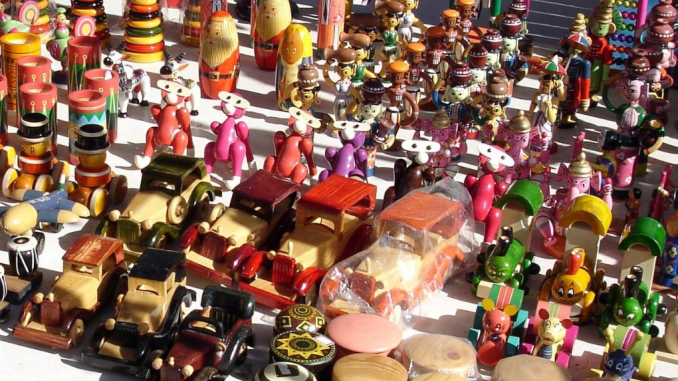
Source – Wikimedia
Through toys one can learn a lot about the culture, economy and social behaviour of people in different eras. Toys are used as symbols and models for different cultures and traditions being followed since past thus keeping the memory of culture alive in present time. Whenever a cultural festival is nearby several toys as models occupy the markets. Their importance in understanding civilisations is appreciable. Toys have been in the Harappan era, the Gupta/Maurya period, and the Mughal as well as the Maratha regimes. Technology and science changed over the centuries and helped humans evolve. For example, “Earlier, the rich bought silver or copper toys while the poor bought clay toys for their children. Terracotta and metal were the most used materials.
The Harappans made toys that had wheels or bobblehead dolls of both humans and animals. The toys show that the economy during that era was flourishing and people were curious and inventive in nature.
In the Maurya/Gupta period, the rich bought toys made of gold and ivory, besides silver. Flourishing economy spurred demand for toys. Human faces and animal figurines were popular. People bought toys of gold, silver and clay, depending on their income.
In the Mughal era, rag dolls made from cotton cloth were also popular. Most toys of that era are figurines of horses, elephants, tigers, lions, kings and armed soldiers made out of copper and silver. Many wars happened in the Mughal period, and this shows in the toys and dolls from those times.
During Maratha Era, grand religious ceremonies were the order of the day, so festive toys were popular. Soldiers, chariots, horses, bullock carts and figures of gods and goddesses made from wood or metal adorned many homes.
In British era, British fascination with tribal culture is reflected in toys depicting different tribes and their festivals. Metal and ceramic were popular materials for making toys.
Some Traditional toys of India:
Kinnal, Karnataka
Near the ancient temple town of Hampi, Kinnal’s toys are exquisite carvings in wood, aided by a host of other materials such as tamarind seeds, pebbles, jute, sawdust and liquid gum used for embossing and ornamentation.
Nirmal, Telangana
Toys in Nirmal were traditionally made using sandalwood and coated with a plant extract that give them their characteristic golden sheen.
Channapatna, Karnataka
Traditionally fashioned from soft ivory wood, Channapatna toys include rattles, tops and stackers known for their light weight, soft edges and bright colours (from lacquer-based dyes). The Channapatna toys are said to have originated and flourished during Tipu Sultan’s rule, in the 18th century.
Krishnanagar, West Bengal
This is the centre of production of the realistic Krishnanagar clay dolls. Traditionally the toys were made by the women and represented social scenes, animals and deities.
Leather toys of Indore, Madhya Pradesh
These are miniature animals in various states of motion. There are tigers, horses, elephants and monkeys, hippos, rhinos, giraffes and kangaroos. This tradition uses leather-moulding techniques said to have evolved from taxidermy. Shredded paper moulds bound by wire and thread are covered in sheepskin to give the toys their muscular look.
Asharikandi, Assam
This craft village is known for making the intricate Hatima doll (above), a mother with elephant ears, holding two infants, Other popular toys made here are the Ainar horse, elephant, rhino and a host of mythical figures.
Varanasi, Uttar Pradesh
The artisans in Varanasi worked in ivory, and were patronised by the Mughals. After ivory was banned in the 1990s, these artisans took up wood carving and turning. They specialise in making complex toys without joints, often representing characters from Hindu mythology.
Thanjavur dolls, Tamil Nadu This is the traditional Indian bobblehead, made from terracotta.

Leave a Reply
You must be logged in to post a comment.